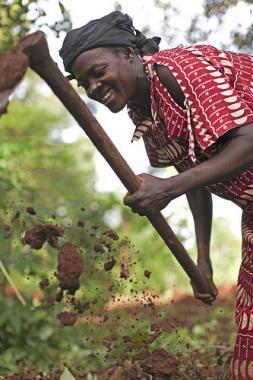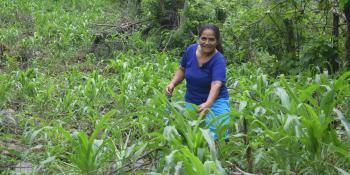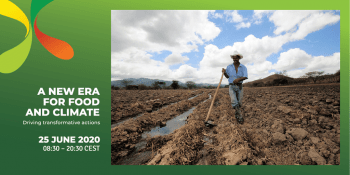Equal access to climate information between men and women farmers? Study suggests no

A recent article by the New York Times reminds us that women in developing countries are increasingly left behind to sustain family farms, as the men migrate to cities in search for work. But discrimination, gender stereotypes and women’s low social status limit their access to fertilizer, seeds, credit, technical assistance and membership in cooperatives and unions.
Therefore, there is a great risk that any adaptative response to communities affected by climate change is not complete if gender is not considered.
The need for a gender-focus in adaptation work was also discussed in one of our more recent Working Papers, “Using a gender lens to explore farmers’ adaptation options in the face of climate change” originating from the researchers investigating gender in the context of climate change, food security and agriculture.
Getting to grips with gender in a food and farming context
The idea for the paper was to test and evaluate gender-sensitive tools and methodologies in the field, in this case in Uganda. The tools and methodologies were developed last year by CCAFS and the Food and Agriculture Organisation of the United Nations (FAO). The “Training Guide for Gender and Climate Change Research in Agriculture and Food Security for Rural Development” is a useful tool for anyone conducting field research on gender, agriculture and climate change.
Gender-sensitive approaches within agriculture research and activities on the ground are crucial in achieving climate smart agriculture. The authors looked at three important CSA initiatives that CCAFS is working on in East Africa, West Africa and South Asia, ranging from climate analogues sites, climate fore casting and specific climate smart agricultural practices to see how gender affects the implementation of these activities. The team worked with women and men separately, as well as youths, in a pilot study, focusing on an Ugandan village called Kyengeza.
casting and specific climate smart agricultural practices to see how gender affects the implementation of these activities. The team worked with women and men separately, as well as youths, in a pilot study, focusing on an Ugandan village called Kyengeza.
So, what did the researchers find?
Financial power, the working paper suggests, to a large degree decides who can buy new crops and fertilizers to the farm. But gender plays a huge role too. Normally, men are the ones in the household responsible for the finances, meaning that in more cases than not, men in this Ugandan village used fertilizers, mulching, livestock manure and micro-irrigation, to mention a few, to a much larger extent than women.
This imbalance impacts productivity on the field to a large degree. A report from FAO (PDF) shows that the yield gap in agriculture, between men and women, averages around 20–30 percent and most research finds that the gap is due to differences in resource use.
Men could also more easily travel into town and purchase what they needed, while the women stayed in the household taking care of children, fetching water, and other duties preventing them from moving too far.
Read more: How farmers' gender-based differences hamper climate adaptation
Tackling the distrust for climate information
Gender also impacted how the villagers received climate information. About 80 per cent of the men listened to the radio, as compared to only 20 per cent of the women. Men were therefore able to receive important climate data and information, whereas women had to rely on indigenous technical knowledge related to weather and farming techniques.
Read also: Pilot radio project tunes in to what farmers have to say
What was interesting was the lack of trust, from both men and women, in the information they received via radio and text messages. The majority of farmers felt that the information lacked accuracy and clarity, and could not be trusted for important on-farm decisions, the paper concludes.
Say it out loud!
Both the men and women say what’s needed is location-specific information distributed in the local language - as not everyone understands English.
The women made a priority list of potential channels to disburse the more locally adapted information, where megaphones was put as the number one channel. A megaphone would overcome some of the immediate obstacles facing women and young females, such as joining official meetings or other activities where climate information is disbursed. It would also mean that women wouldn’t have to rely on radios, which in some instances they can’t access, afford or, also, can’t get a good connection for, while out in the fields. Other channels included using farmers’ organisations, recieving information via school children and village leaders.
It could make all the difference to say it out loud, instead of relying only on radio waves and new technology. Sometimes, simple technology goes a long way!
At the same time, improving the messages delivered via radio and SMS should also be made a priority, as especially text messages have shown to have great potential in delivering good climate information to farmers.
Read also: Cell phones connect farmers to a food secure future
Download Working Paper: Using a gender lens to explore farmers’ adaptation option in the face of climate change: Results of a pilot study in Uganda. Kyazze, F.B., Owoyesigire, B., Kristjanson, P., Chaudhury, M. 2012. CCAFS Working paper 26.
Download Training Manual: Training Guide for Gender and Climate Change Research in Agriculture and Food Security for Rural Development
Written by Cecilia Schubert, Communications Assistant at CCAFS Coordinating Unit. Want to learn more about our gender work? Read our gender-brief and follow us on Twitter and Facebook for updates. You can also visit our site dedicated to gender: www.ccafs.cgiar.org/gender



